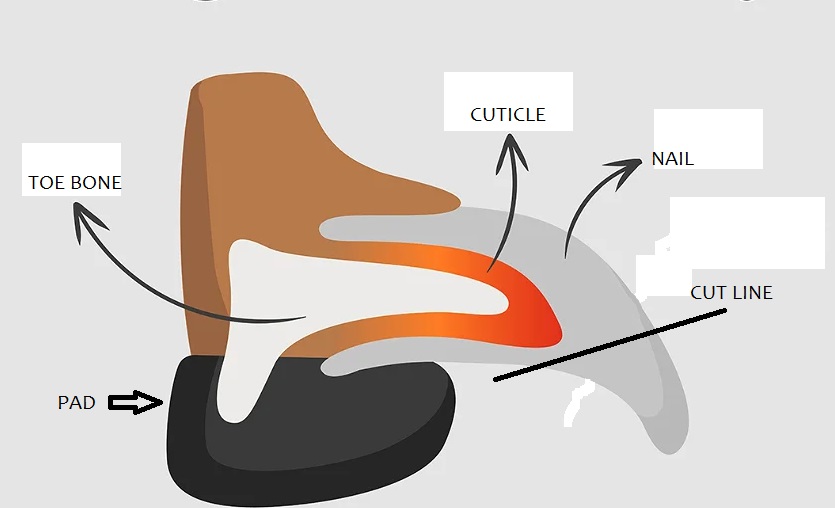
When tappity tap becomes a problem for your dog…
If you think a paper cut is painful, imagine your dog’s nails splitting all the way to the nail bed. Read how you can avoid problem nails from puppyhood.
Nail care from the start
If you are a dog owner, you may have noticed that nails are an ongoing (or on-growing) concern. Let’s look at some of the ways we can keep our dogs’ nails healthy.
Puppy pins
Got a new puppy that is not allowed contact with other dogs until those vaccinations are effective? Experienced the needle-point scratches on your skin from those playful bouts? Or, have you tried to extricate your pup’s little hooks from a blanket or clothing?
A new puppy is possibly the most rewarding experience in your life but boy, do those little tappers grow quickly. If not fully vaccinated, it may be too risky to walk your puppy on a rough public surface like a road or a pavement, so how do we tame those nails at home?
Many animals have an innate dislike of their feet being handled and, as a vet nurse, I have seen that it only takes one slip of the nail trimmer that catches the sensitive cuticle to put your dog off nail cutting for life. Starting gently from puppyhood can prevent a lifelong struggle when it comes to manicures.
Puppy nails are thankfully quite soft and the best approach from an early age is a nail file or emery board. For larger breed puppies, a human nail clipper will suffice as long as the cutting edges are sharp. Also, if this is done gently in combination with a reward, your puppy will grow up to understand that the handling of his or her feet is not a painful procedure.
Anatomy of the tapper
Understanding the anatomy of the nail is the first vital step towards a pain (and blood) free claw trim.
Like human fingers, a dog’s toe has three bones (phalanxes). The last bone is pointed (ungual process) and provides form and support for the surrounding cuticle or quick. The quick of the nails contain nerves and blood vessels (which supply nutrients to cells that manufacture nails).

Nail diseases
There are a number of challenges that your doggo’s nails can face from bacterial and fungal infections to auto-immune diseases, cancer and physical deformities. Some nail deformities can even be caused by nutritional deficiencies.
An infected nail can usually be treated successfully with anti-microbials but auto-immune diseases (most of which have horrendous names i.e. Lupoid onychodystrophy are beyond the scope of this article to mention) and nutritional deficiencies that cause nails to be brittle or deformed are more challenging to treat.
In most cases, a veterinarian will take samples from diseased nails in order to make an accurate diagnosis.
Just cut to the chase
Consider the cuticle as a mobile factory; you will see that as it builds the nail it still needs a channel to deliver nutrients to the nail-building cells. This channel gets longer as the nail grows. When you cut the nail, the channel retracts in order to protect blood vessels and nerves from the dirty surface. This is why very long nails need to be trimmed gradually — and this can take a few weeks to achieve — to allow the quick to retract.
White nails are much easier to cut than black nails because the cuticle is usually visible as a little pink ‘beak’ inside the nail. The nail should be cut at a parallel angle to the ground and the tip of the cuticle should be avoided by at least 2 millimetres.
Black nails are more of a challenge. But here’s one of those reasons you love to read Vet Nurse View articles: a top tip! Check if your dog has any white nails amongst the 16 nails (excluding dewclaws). One white nail can indicate how much to cut off the black nails. If there are no white nails, a few millimetres cut off each week until the correct length is achieved is the way to go. The correct length is when the nail hangs a few millimetres above the ground’s surface. A nail that touches the ground when your dog is walking on a flat surface is considered too long.
How to keep them down
A dog’s nails play an important role in the ambulatory process. They grip the ground when running and are used to dig as well. If your dog only walks on carpeting or grass, you may notice that their nails are not naturally worn down and they must be cut. So a good tip is to take your furry friend out onto rough surfaces for walkies.
Those curly little thumbs
The dewclaws; what strange little things! Dewclaws are like thumbs. They help dogs with traction when they are climbing steep inclines and to grip bones when they are chewing but most domestic pampered doggos never get to use them. They have the nasty habit of growing in a circle. This is the natural curvature of the ungual process mentioned previously. It is vital to trim them regularly because, if left too long, they can grow right around into the nail pad which is extremely painful. Some dog breeds have very loose and floppy dewclaws that are not connected to the underlying bone. They have the annoying habit of snagging on everything and there is a danger that they can rip off. This is why it may be necessary to remove them surgically.
In case of emergency
If your dog’s nails are physically damaged, they may split and bleed. The worst scenario is the complete loss of the nail which exposes the sensitive cuticle and sedation may be necessary to remove split pieces of nail or the paw bandaged. If the nail is damaged and bleeding, you can prevent further damage by wrapping a clean cloth or dressing over the foot being careful not to make it too tight. Get to your vet or vet nurse as soon as you can.
Successful manicures are within the reach of most pet owners but remember that vet nurses perform nail trimming regularly and are the best people to approach for this procedure if your pet is anxious.
It is important to remember that odd-looking nails should never be ignored. Some diseases can cause nails to grow too fast and split so it is wise to head to the vet if you see any unnatural changes in your pet’s nails.
Happy tapping!
©Liz Roodt 2024
